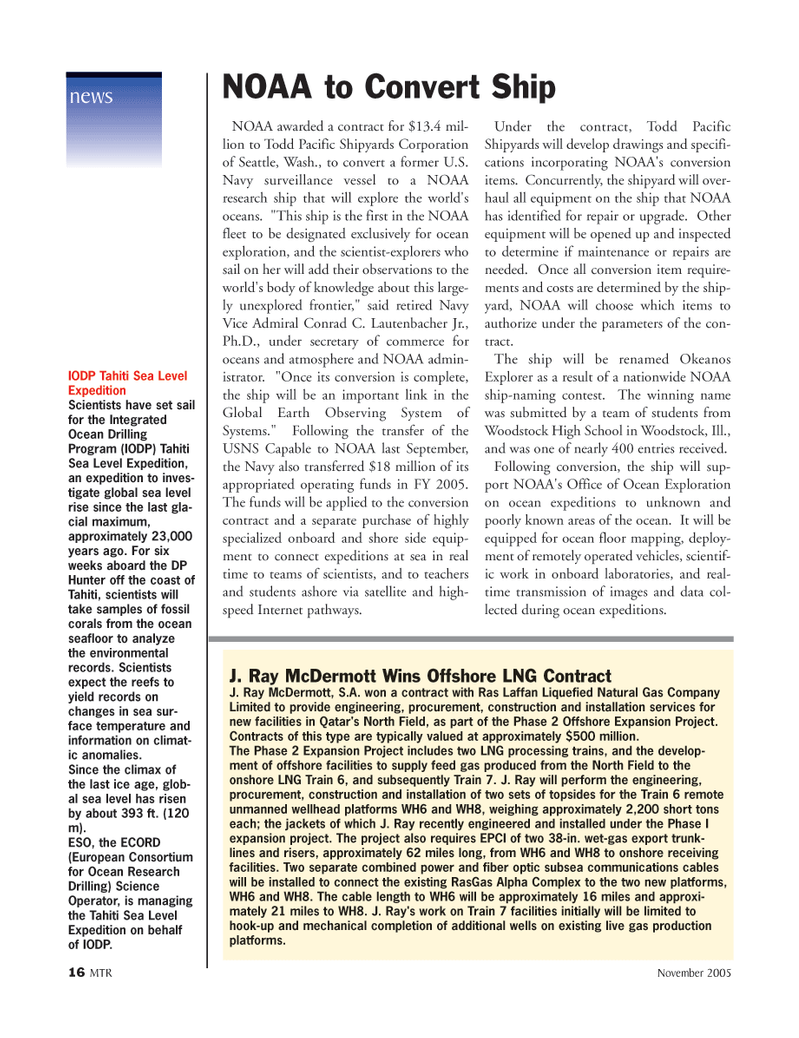
Page 16: of Marine Technology Magazine (November 2005)
Seafloor Engineering
Read this page in Pdf, Flash or Html5 edition of November 2005 Marine Technology Magazine
16 MTR November 2005
NOAA awarded a contract for $13.4 mil- lion to Todd Pacific Shipyards Corporation of Seattle, Wash., to convert a former U.S.
Navy surveillance vessel to a NOAA research ship that will explore the world's oceans. "This ship is the first in the NOAA fleet to be designated exclusively for ocean exploration, and the scientist-explorers who sail on her will add their observations to the world's body of knowledge about this large- ly unexplored frontier," said retired Navy
Vice Admiral Conrad C. Lautenbacher Jr.,
Ph.D., under secretary of commerce for oceans and atmosphere and NOAA admin- istrator. "Once its conversion is complete, the ship will be an important link in the
Global Earth Observing System of
Systems." Following the transfer of the
USNS Capable to NOAA last September, the Navy also transferred $18 million of its appropriated operating funds in FY 2005.
The funds will be applied to the conversion contract and a separate purchase of highly specialized onboard and shore side equip- ment to connect expeditions at sea in real time to teams of scientists, and to teachers and students ashore via satellite and high- speed Internet pathways.
Under the contract, Todd Pacific
Shipyards will develop drawings and specifi- cations incorporating NOAA's conversion items. Concurrently, the shipyard will over- haul all equipment on the ship that NOAA has identified for repair or upgrade. Other equipment will be opened up and inspected to determine if maintenance or repairs are needed. Once all conversion item require- ments and costs are determined by the ship- yard, NOAA will choose which items to authorize under the parameters of the con- tract.
The ship will be renamed Okeanos
Explorer as a result of a nationwide NOAA ship-naming contest. The winning name was submitted by a team of students from
Woodstock High School in Woodstock, Ill., and was one of nearly 400 entries received.
Following conversion, the ship will sup- port NOAA's Office of Ocean Exploration on ocean expeditions to unknown and poorly known areas of the ocean. It will be equipped for ocean floor mapping, deploy- ment of remotely operated vehicles, scientif- ic work in onboard laboratories, and real- time transmission of images and data col- lected during ocean expeditions. news
NOAA to Convert Ship
J. Ray McDermott Wins Offshore LNG Contract
J. Ray McDermott, S.A. won a contract with Ras Laffan Liquefied Natural Gas Company
Limited to provide engineering, procurement, construction and installation services for new facilities in Qatar's North Field, as part of the Phase 2 Offshore Expansion Project.
Contracts of this type are typically valued at approximately $500 million.
The Phase 2 Expansion Project includes two LNG processing trains, and the develop- ment of offshore facilities to supply feed gas produced from the North Field to the onshore LNG Train 6, and subsequently Train 7. J. Ray will perform the engineering, procurement, construction and installation of two sets of topsides for the Train 6 remote unmanned wellhead platforms WH6 and WH8, weighing approximately 2,200 short tons each; the jackets of which J. Ray recently engineered and installed under the Phase I expansion project. The project also requires EPCI of two 38-in. wet-gas export trunk- lines and risers, approximately 62 miles long, from WH6 and WH8 to onshore receiving facilities. Two separate combined power and fiber optic subsea communications cables will be installed to connect the existing RasGas Alpha Complex to the two new platforms,
WH6 and WH8. The cable length to WH6 will be approximately 16 miles and approxi- mately 21 miles to WH8. J. Ray's work on Train 7 facilities initially will be limited to hook-up and mechanical completion of additional wells on existing live gas production platforms.
IODP Tahiti Sea Level
Expedition
Scientists have set sail for the Integrated
Ocean Drilling
Program (IODP) Tahiti
Sea Level Expedition, an expedition to inves- tigate global sea level rise since the last gla- cial maximum, approximately 23,000 years ago. For six weeks aboard the DP
Hunter off the coast of
Tahiti, scientists will take samples of fossil corals from the ocean seafloor to analyze the environmental records. Scientists expect the reefs to yield records on changes in sea sur- face temperature and information on climat- ic anomalies.
Since the climax of the last ice age, glob- al sea level has risen by about 393 ft. (120 m).
ESO, the ECORD (European Consortium for Ocean Research
Drilling) Science
Operator, is managing the Tahiti Sea Level
Expedition on behalf of IODP.
MTR#3 (1-16).qxd 11/15/2005 2:21 PM Page 18

 15
15

 17
17
